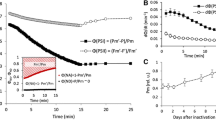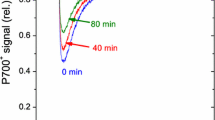Abstract
Photoinactivation of Photosystem (PS) II in vivo was investigated by cumulative exposure of pea, rice and spinach leaves to light pulses of variable duration from 2 to 100 s, separated by dark intervals of 30 min. During each light pulse, photosynthetic induction occurred to an extent depending on the time of illumination, but steady-state photosynthesis had not been achieved. During photosynthetic induction, it is clearly demonstrated that reciprocity of irradiance and duration of illumination did not hold: hence the same cumulative photon exposure (mol m−2) does not necessarily give the same extent of photoinactivation of PS II. This contrasts with the situation of steady-state photosynthesis where the photoinactivation of PS II exhibited reciprocity of irradiance and duration of illumination (Park et al. (1995) Planta 196: 401–411). We suggest that, for reciprocity to hold between irradiance and duration of illumination, there must be a balance between photochemical (qP) and non-photochemical (NPQ) quenching at all irradiances. The index of susceptibility to light stress, which represents an intrinsic ability of PS II to balance photochemical and non-photochemical quenching, is defined by the quotient (1-qP)/NPQ. Although constant in steady-state photosynthesis under a wide range of irradiance (Park et al. (1995). Plant Cell Physiol 36: 1163–1169), this index of susceptibility for spinach leaves declined extremely rapidly during photosynthetic induction at a given irradiance, and, at a given cumulative photon exposure, was dependent on irradiance. During photosynthetic induction, only limited photoprotective strategies are developed: while the transthylakoid pH gradient conferred some degree of photoprotection, neither D1 protein turnover nor the xanthophyll cycle was operative. Thus, PS II is more easily photoinactivated during photosynthetic induction, a phenomenon that may have relevance for understorey leaves experiencing infrequent, short sunflecks.
Similar content being viewed by others
Abbreviations
- D1 protein:
-
psbA gene product
- DTT:
-
dithiothreitol
- Fv, Fm, Fo :
-
variable, maximum, and initial (corresponding to open traps) chlorophyll fluorescence yield, respectively
- NPQ:
-
non-photochemical quenching
- PS:
-
Photosystem
- QA :
-
primary quinone acceptor of PS II
- qP:
-
photochemical quenching coefficient
References
Bell CJ and Rose DA (1981) Light measurement and the terminology of flow. Plant Cell Environ 4: 89–96
Bilger W and Björkman O (1990) Role of the xanthophyll cycle in photoprotection elucidated by measurements of light-induced absorbance changes, fluorescence and photosynthesis in leaves of Hedera canariensis. Photosynth Res 25: 173–185
Bilger W and Björkman O (1994) Relationships among violaxanthin deepoxidation, thylakoid mambrane conformation, and non-photochemical chlorophyll fluorescence quenching in leaves of cotton (Gossypium hirsutum L.). Planta 193: 238–246
Bilger W, Björkman O and Thayer SS (1989) Light-induced spectral absorbance changes in relation to photosynthesis and the epoxidation of the xanthophyll cycle compounds in cotton leaves. Plant Physiol 91: 542–551
Danon A and Mayfield SP (1994) Light-regulated translation of messenger RNAs through redox potential. Science 266: 1717–1719
Demmig-Adams B and AdamsIII WW (1992) Photoprotection and other responses of plants to high light stress. Annu Rev Plant Physiol Plant Mol Biol 43: 599–626
Chow WS (1994) Photoprotection and photoinhibitory damage. Adv Mol Cell Biol 10: 151–196
Chow WS, Hope AB and Anderson JM (1991) Further studies on quantifying PS II in vivo by flash-induced oxygen yield from leaf discs. Aust J Plant Physiol 183: 397–410
Franklin LA, Lavavasseur G, Osmond C B, Henley WJ and Ramus J (1992). Two components of onset and recovery during photoinhibition of Ulva rotundata. Planta 186: 399–408
Jones LW and Kok B (1966) Photoinhibition of chloroplast reactions. Plant Physiol 41: 1037–1043
Ögren E (1991) Prediction of photoinhibition in willow leaves under field conditions. Planta 184: 538–544
Öquist G, Chow WS and Anderson JM (1992) Photoinhibition of photosynthesis represents a mechanism for the long-term regulation of Photosystem II. Planta 186: 450–460
Osmond CB (1994) What is photoinhibition? Some insights from comparisons of shade and sun plants. In: Baker NR and Bowyer JR (eds) Photoinhibition of Photosynthesis: From Molecular Mechanisms to the Field, pp 1–24. Bios Scientific Publishers, Oxford
Park Y-I, Chow WS and Anderson JM (1995a) Light inactivation of functional PS II in leaves of peas grown in moderate light depends on photon exposure. Planta 196: 401–411
Park Y-I, Anderson JM and Chow WS (1995b) Photoinacivation of functional Photosystem II and D1-protein synthesis in vivo are independent of the modulation of the photosynthetic apparatus by growth irradiance. Planta 197 (in press)
Park Y-I, Chow WS and Anderson JM (1995c) The quantum yield of photoinactivation of Photosystem II in pea leaves is greater at low than high photon exposure. Plant Cell Physiol 36: 1163–1167
Schreiber U and Neubauer C (1990) O2-dependent electron flow, membrane energization and the mechanism of non-photochemical quenching of chlorophyll fluorescence. Photosynth Res 25: 279–293
vanKooten O and Snel JFH (1990) Progress in fluorescence research and nomenclature for quenching analysis. Photosynth Res 25: 147–150
Walker DA (1976) CO2 fixation by intact chloroplasts: Photosynthetic induction and its relation to transport phenomena and control mechanisms. In: Barber J (ed) The Intact Chloroplast, pp 235–278. Elsevier, Amsterdam
Author information
Authors and Affiliations
Rights and permissions
About this article
Cite this article
Shen, YK., Chow, W.S., Park, YI. et al. Photoinactivation of photosystem II by cumulative exposure to short light pulses during the induction period of photosynthesis. Photosynth Res 47, 51–59 (1996). https://doi.org/10.1007/BF00017753
Received:
Accepted:
Issue Date:
DOI: https://doi.org/10.1007/BF00017753




